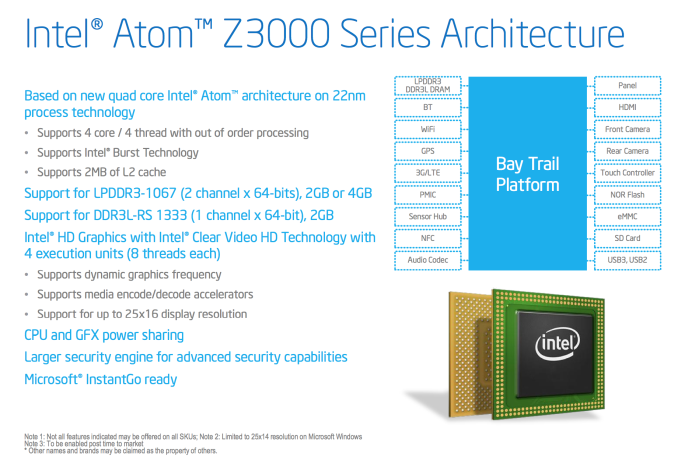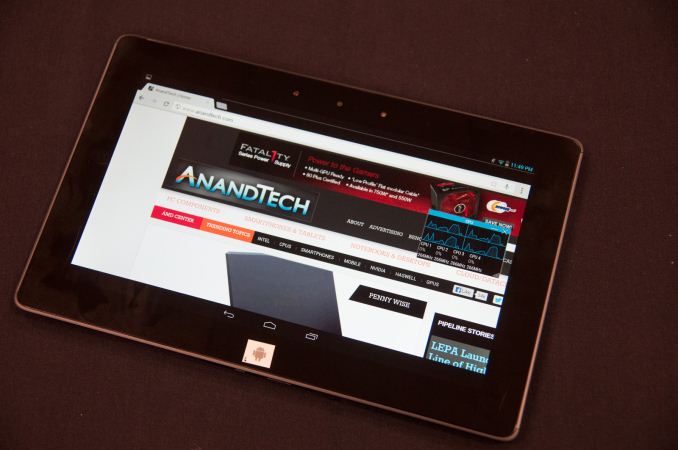The Bay Trail Preview: Intel Atom Z3770 Tested
by Anand Lal Shimpi & Brian Klug on September 11, 2013 12:00 PM ESTFinal Words
At its Silvermont disclosure, Intel promised performance better than any other ARM based core in the market today. Looking at our Android results, Intel appears to have delivered on that claim. Whether we’re talking about Cortex A15 in NVIDIA’s Shield or Qualcomm’s Krait 400, Silvermont is quicker. It seems safe to say that Intel will have the fastest CPU performance out of any Android tablet platform once Bay Trail ships later this year.
The power consumption, at least on the CPU side, also looks very good. From our SoC measurements it looks like Bay Trail’s power consumption under heavy CPU load ranges from 1W - 2.5W, putting it on par with other mobile SoCs that we’ve done power measurements on.
On the GPU side, Intel’s HD Graphics does reasonably well in its first showing in an ultra mobile SoC. Bay Trail appears to live in a weird world between the old Intel that didn’t care about graphics and the new Intel that has effectively become a GPU company. Intel’s HD graphics in Bay Trail appear to be similar in performance to the PowerVR SGX 554MP4 in the iPad 4. It’s a huge step forward compared to Clover Trail, but clearly not a leadership play, which is disappointing.
The big unknowns are things like video decode power efficiency, perf and quality of their ISP and idle power efficiency vs. Qualcomm.
Bay Trail looks like a good starting point for Intel in mobile, and the performance of Silvermont makes me excited for Merrifield in phones next year. What Intel needs to do going forward is simply continue to iterate and execute for the next few generations after Bay Trail and it will have a real chance at success in mobile.
My biggest concern is about the design wins we see based around Bay Trail. Although Intel is finally in a spot where it can be in devices on the market, none of those devices thus far have been any good. Bay Trail is attractive enough to garner more design wins for certain, the question is whether or not the quality of those wins will improve as well. In the tablet market there’s the iPad and the Nexus lines that are really the most interesting, and I don’t expect Bay Trail to be in either. Whether or not the quality of the rest goes up this generation and we find a Bay Trail in one of those devices remains to be seen.












190 Comments
View All Comments
PEJUman - Wednesday, September 11, 2013 - link
NVM, some googling answers my question. Cool.. I learn something today.Kidster3001 - Thursday, September 12, 2013 - link
All of Android runs in a VM. Every Android device in the world. Apps can call native routines via JNI and some apps do contain native *.so libraries (for multiple ISA's) but in the end, Android is a VM. Your UI, your system apps, everything runs through Dalvik.The difference between Atom devices and ARM devices is that Intel has included a binary translator to convert the ARM *.so to x86 code on-the-fly. If there are no x86 .so included in the app then the x86 device will use the ARM-v7a library via the translator.
It is very easy for app developers to compile their libraries natively if they choose. Most apps have NO native libraries in them, they're all Java. When compiling a native app, just tell the system which ISAs to compile for. Of those apps which do have native components most compile for ARM, ARM-v7a and MIPS. Flicking another switch to also compile for x86 is not that difficult.
monstercameron - Friday, September 13, 2013 - link
kabini android, nope those are most likely the windows results.lmcd - Wednesday, September 11, 2013 - link
Yeah, I imagine or at least hope Kabini + HPL process is on the queue. That would make Intel work a bit harder.Nagorak - Wednesday, September 11, 2013 - link
It wouldn't be anywhere close. AMD doesn't have Intel's process advantage. If AMD could get power down by just cutting GPU performance then they probably would have done so. In a tablet power consumption is pretty damn important.In fact, more so than these load tests, idle power consumption is probably the key, and that wasn't fully tested at this point.
andrewaggb - Wednesday, September 11, 2013 - link
I kinda expected more. It should make for a decent windows 8 tablet, but given that the new iphone has 2x cpu/gpu I think it's pretty safe to say the next ipad will destroy this thing graphically.Intel needs to become a graphics leader now.... not in 2-5 years.
kyuu - Wednesday, September 11, 2013 - link
Obviously the proper comparison here would be with Temash, since that's AMD's tablet SoC. Kabini isn't meant to compete with Bay Trail in power consumption, so it's pretty far from a surprise that it draws more power.I'm guessing the results would be pretty much the same: Bay Trail beats Temash slightly in CPU benches, but still gets soundly thrashed in GPU benches.
Also, don't the current Kabini SKUs lack AMD's equivalent of turbo boosting? I thought I saw that on the Kabini review article...
silverblue - Wednesday, September 11, 2013 - link
The comparison with Kabini is an interesting one. Kabini supports more instruction sets (Bay Trail is Westmere-level which means it lacks AVX) but it has a single memory channel and lacks any form of turbo. Amusingly though, Kabini is practically on-par here in terms of single threading (per clock) but is being hampered a little in multi-threading if 7-Zip is any indication (memory bandwidth?).Add in turbo to Kabini and the Bay Trail advantage in single-threading disappears, but power usage is obviously higher. AMD have their work cut out here; Beema (and HSA) can't come soon enough.
I think AMD's yearly cadence will help here - Beema has HSA plus GCN2.0 at the very least on a more mature 28nm process - however AMD will still be on 28nm when Intel goes 14nm. Still, if HSA is the be-all-and-end-all that we've been told it is, they have hope.
The 4600M is embarrassed in CineBench; clock either SoC at 2GHz and they'll equal it for far less power. CineBench is very Intel-friendly, though the same trick in 7-Zip's multi-threaded test would result in the same outcome. Proof indeed that Kaveri is needed.
zeo - Wednesday, September 11, 2013 - link
Kabini has Turbo, only the two dual core Temash models drops it... and Bay Trail has its alternative to Turbo Boost that's called Burst technology...And HSA requires industry support... they need to make it a standard, which is why they started up the HSA Foundation, but until that happens then it's only a novelty like Nvidia's CUDA, and right now it's mainly just ARM backing them there so far...
silverblue - Thursday, September 12, 2013 - link
The only Jaguar-based chip (outside of consoles) with any turbo functionality (note I'm typing "turbo" in lower case as I'm referring to the basic technology and not a specific implementation) is, at this time, the A6-1450, which is a Temash chip. In addition, without the turbo dock, it cannot actually achieve its turbo frequencies.As regards HSA, here's something quoted from the AMD website:
"The founding members of HSA are: AMD, ARM, Imagination Technologies, MediaTek, Texas Instruments, Samsung Electronics and Qualcomm®."
Consider that ARM is what generally binds most of these together, and their huge dominance of the smartphone and tablet market, and you can easily see that HSA isn't just another "novelty like Nvidia's CUDA".
http://developer.amd.com/resources/heterogeneous-c...